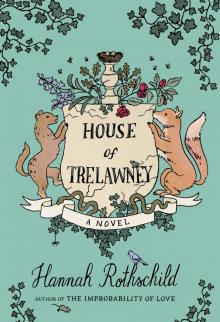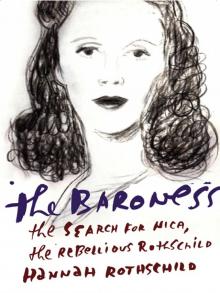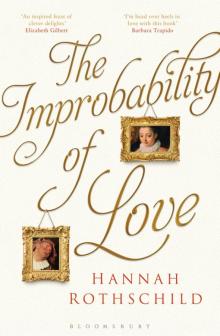- Home
- Hannah Rothschild
House of Trelawney
House of Trelawney Read online
ALSO BY HANNAH ROTHSCHILD
The Improbability of Love
The Baroness: The Search for Nica, the Rebellious Rothschild
THIS IS A BORZOI BOOK
PUBLISHED BY ALFRED A. KNOPF
Copyright © 2020 Hannah Rothschild
All rights reserved. Published in the United States by Alfred A. Knopf, a division of Penguin Random House LLC, New York, and distributed in Canada by Penguin Random House Canada Limited, Toronto. Simultaneously published in hardcover in Great Britain by Bloomsbury Publishing Plc, London.
www.aaknopf.com
Knopf, Borzoi Books, and the colophon are registered trademarks of Penguin Random House LLC.
Library of Congress Cataloging-in-Publication Data
Names: Rothschild, Hannah, [date] - author.
Title: House of Trelawney / Hannah Rothschild.
Description: London : Bloomsbury Publishing, 2020.
Identifiers: LCCN 2019028762 (print) | LCCN 2019028763 (ebook) | ISBN 9780525654919 (hardcover) | ISBN 9780525654926 (ebook) | ISBN 9781524711757 (open market)
Subjects: LCSH: Domestic fiction.
Classification: LCC PR6118.O8755 H68 2020 (print) | LCC PR6118.O8755 (ebook) | DDC 823/.92—dc23
LC record available at https://lccn.loc.gov/2019028762
LC ebook record available at https://lccn.loc.gov/2019028763
Ebook ISBN 9780525654926
This is a work of fiction. Names, characters, places, and incidents either are the product of the author’s imagination or are used fictitiously. Any resemblance to actual persons, living or dead, events, or locales is entirely coincidental.
Cover illustration by Sacha Floch Poliakoff
Cover design by Megan Wilson
v5.4
ep
Contents
Cover
Also by Hannah Rothschild
Title Page
Copyright
Dedication
Chapter 1: Trelawney Castle
Chapter 2: Moonshot Wharf
Chapter 3: The Train Journey
Chapter 4: The Presentation
Chapter 5: Attics
Chapter 6: Fleas and Sparrows
Chapter 7: Blaze Takes a Trip
Chapter 8: The Arrival
Chapter 9: Kitto Unleashed
Chapter 10: Volcanoes
Chapter 11: Big Shot
Chapter 12: The Date
Chapter 13: The Burial
Chapter 14: The Wake
Chapter 15: Picking Up the Pieces
Chapter 16: The Letter
Chapter 17: Propositions
Chapter 18: The Festive Season
Chapter 19: Sleet Hall
Chapter 20: Seeds
Chapter 21: Black Monday
Chapter 22: Hot Chocolate
Chapter 23: Curtains
Chapter 24: Red Tape
Chapter 25: The Auction Room
Chapter 26: The Opening
Chapter 27: An Afternoon
Chapter 28: Pools and Butterflies
Chapter 29: The Birthday Party
Chapter 30: The Coffee Shop
Chapter 31: One Day in May
Chapter 32: The Naming Ceremony
Acknowledgements
A Note About the Author
To Yoav
1
Trelawney Castle
WEDNESDAY 4TH JUNE 2008
Trelawney Castle, home to the same family for eight hundred years, sits on a bluff of land overlooking the South Cornish sea. Since their ennoblement in 1179, the Earls of Trelawney used wealth and stealth to stay on the winning side of history; ruthlessly and unscrupulously switching allegiances or bribing their way to safety and positions of authority. The castle was their three-dimensional calling card, the physical embodiment of their wealth and influence. Each Earl added an extension until it was declared the grandest, if not the finest, stately home in the county of Cornwall.
In summer months, until the First World War, it was the custom of the family and guests to take the Trelawney barge from the Trelawney boathouse, through Trelawney land, past Trelawney follies and temples, to Trelawney Cove where they could use the seaside house (Little Trelawney Castle) or sail the yacht (the Trelawney). In the winter, the same ilk would hunt with the Trelawney foxhounds or shoot game raised on the Trelawney Estate. At that time, the family were so landed and powerful that they could travel from Trelawney to Bath, from the south coast to the Bristol Channel, without stepping off their own domain. This swathe of England became known as Trelawneyshire, an area of 500,000 acres including forty miles of coastline. With the advent of the railway, those family members who chose to go as far as London (most refused and who could blame them) would travel from Trelawney Station in a private train stamped inside and out with the Trelawney coat of arms.
By the early nineteenth century, the castle had expanded sufficiently to have a room for each day of the year, eleven staircases and four miles of hallways. After King George III’s favourite mistress became hopelessly lost in the maze of corridors and nearly died from hypothermia, guests were, thenceforth, given a miniature crested silver casket containing different-coloured confetti to sprinkle on the floor, so as to leave a personal trail to and from their bedrooms.
The Victorian diarist Rudyard Johnson, a regular guest, wrote: “The castle is made of four main blocks, each built a century apart in markedly different styles. Part of the amusement of Trelawney is sleeping in an Elizabethan bedroom, breakfasting in a Jacobean hall, taking tea in a Regency conservatory and dancing in a Georgian ballroom. For those who like a morning constitutional, the battlement walk is a perfect 400-yard perambulation.” The respected eighteenth-century architectural historian J. M. Babcock dismissed the castle as “a vomitorium of conflicting architectural styles, reflecting the whims of wealthy, ill-educated and self-indulgent aristocrats.”
Until the early twentieth century, rooms were lit by candle or oil lamps and warmed by open fires. Hot water was prepared in vast cauldrons on stoves in the basement and carried in buckets to the bathrooms. Even human waste, kept in porcelain dishes mounted in wooden boxes or cupboards, was disposed of by (a servant’s) hand. Eighty-five members of domestic staff were employed to carry out those tasks, including a butler, housekeeper, kitchen maids, footmen, chars and a clock man; outside there were sixty more, ranging from gardeners and grooms to mole catchers and coachmen, and even a bear and camel keeper. In 1920 the decision was taken to instal central heating, plumbing and electricity. It was a Sisyphean task, started but never finished. Only the Georgian wing was modernised, providing nine bathrooms for eighty-four bedrooms and a total of eleven radiators.
The castle made its own music: pipes hissed and gurgled; house-parties filled the septic tanks under the cellars; and a constant plop and gurgle underscored every activity. Wide wooden floorboards let out little squeaks and groans as they shrank and expanded in changing temperatures. Wind whistled round the crenellations, storms rattled windowpanes. The huge boilers in the basement shuddered while the water tanks in the attics bubbled and whooshed. Little wonder that the family thought of their home as a sentient being: in their eyes, Trelawney was far more than bricks and mortar.
The beauty of the interiors paled next to Trelawney’s setting. To the north of the castle were four hundred acres of medieval oak woods, set in deep cushions
of moss laced with streams chasing over granite boulders. In the heart of the forest there was a perfectly round and deep lake, fed by a waterfall. At different times of the year, the glades were carpeted with flowers—crocuses, snowdrops, bluebells, wild garlic and rare orchids. In these Elysian settings lived native fallow, roe and red deer, thirty types of songbird, thirty-four varieties of butterfly, sixteen different species of moths, as well as foxes, badgers, otters, stoats, weasels, mice, voles, moles, slow-worms and snakes.
To the east and west were undulating meadows dotted with sheep and cows and also arable fields. For eight centuries this rich and fertile area was the breadbasket of the West Country and provided added income to the family’s coffers. It was the southern perimeter, however—some sixty acres of landscaped garden leading down to the estuary—which guests recalled with awe. Successive generations of Earls and their wives had tamed and reshaped the terrain, creating walks and waterways, avenues, terraces, sunken gardens, raised beds, topiary, wild-flower meadows, exotic palmeries, carpet bedding and a 24-acre walled kitchen garden. Wending through the pleasure grounds were streams, waterfalls and, to the south, a vast rhododendron and azalea forest surrounded by ancient laurels. Vistas and views were punctuated with Doric temples and triumphal arches. There were secret grottos and fierce fountains that, by an ingenious natural system of displacement, shot jets of water more than fifty feet into the air. The combination of the manicured and the wild, the conflagration of man’s determined hand and nature’s attributes, created an unforgettable experience. Trelawney was, everyone agreed, the most captivating setting in the British Isles.
As the centuries tripped by, the Earls of Trelawney, their senses and ambition dulled by years of pampered living, failed to develop other skills. Of the twenty-four Earls, the last eight had been dissolute and bereft of any business acumen. Their financial ineptitude, along with two world wars, the Wall Street Crash, three divorces and inheritance taxes, had dissipated the family’s fortune. Bit by bit the accoutrements of wealth disappeared. Servants went to war, not to be replaced. Farms were sold along with the London mansion. The private train and barge were left to rust and rot. Wings of the castle were closed up. Little Trelawney Castle was sold and became a hotel.
The good paintings and furniture were auctioned off and all that remained were their scars: discoloured squares and rectangles on walls or awkward absences in rooms. The only objects left were those without financial value, testaments to the whims and enthusiasms of generations of Trelawneys—such as the enormous stuffed polar bear in the west entrance hall, its fur and fangs turned yellow by time.
The tapestries in the Great Hall and corridors, formerly a riot of vibrantly coloured woven silks, had faded to monochromic pastels and hung in shreds. Worn-through carpets revealed wooden floorboards. Horsehair stuffing and rusty springs poked out of sofas. Broken chairs lay where last used, wooden corpses in a losing battle against maintenance. Red velvet curtains, burnt by sunlight, had turned a uniform grey. Windows were obscured by the march of ivy and bramble on the outer walls. In some places the ceilings had fallen in, exposing floors above. Swathes of wallpaper flapped disconsolately in draughty rooms. The present incumbents chose to avoid setting foot in most of the castle. For them locking doors meant keeping decay at bay. Occasionally a great crash of avalanching plaster could be heard falling like a tree in a faraway wood. Once a child had nearly plummeted through a first-floor landing into the morning room below, but these occurrences were quickly forgotten, stashed away in the department of unhelpful memories.
Nowhere was the reversal of the family fortunes more evident than in the once-famous gardens: nature had slowly and inexorably taken back her land. The waterways were choked with lily pads; the ponds silted up; the hedges, now unclipped, spread across paths; the carefully manicured beds had gone to seed; the yew and beech hedges were blowsy; the rhododendron and azalea, fighting each other for light, had grown tall and raggedy. The fountains spluttered. Buddleia ran amok. The kitchen-garden vegetables had bolted years before. The temples and arches were covered with ivies and vines.
Amidst the chaos and decrepitude inside and out, one relatively small patch of garden remained beautifully and obsessively tended, and on this June afternoon of 2008, Jane, the Viscountess Tremayne, daughter-in-law of the 24th Earl of Trelawney, wife of the heir Kitto, worked diligently amongst the roses, refusing to admit defeat against the army of encroaching weeds. For her, keeping control of this area of garden was a form of therapy; she found double-digging and deadheading calming. That morning, a seemingly innocuous letter, written on two sheets of airmail onion paper, had been so upsetting that she’d taken the first opportunity to come outside with a trowel and a pair of clippers.
Jane Tremayne was forty-one. Her figure was kept trim by the endless stairs of the castle, by tending the garden, seeing to most of the domestic chores, looking after her ageing parents-in-law and her three children, as well as riding and mucking out the last horse in the stables. With fine brown hair beginning to grey around the temples, Jane had pale skin, eyes nearer the colour of grey than blue and weather-beaten rosy cheeks. Had she bothered to take the slightest interest in her appearance, she might have passed as a handsome woman. As it was, with her badly cut hair (kitchen scissors), faded overalls and rough, unmanicured hands, she looked more like a labourer than most people’s idea of an aristocrat.
The family’s Labrador lay supine by the box hedge, occasionally raising its handsome black head to snap half-heartedly at a passing fly. A trained gun dog, Pooter spent most winter weekends with Jane’s husband at someone else’s pheasant shoot (their own had been abandoned in the late 1980s). Though he could not return invitations, Kitto was a valued guest in circles that admired a distinguished title, a first-class shot and a keen drinker. When his master was home, Pooter ignored Jane except at mealtimes. Jane’s three children took much the same line as the Labrador, using their mother as a glorified taxi and meal service. Her elder son Ambrose was in his last year at Harrow but, due to exorbitant public-school fees, her younger son Toby and daughter Arabella had been sent to the local comprehensive.
The letter, when it arrived after breakfast, had sat glaring at her from the fruit bowl on the kitchen table. Jane tried covering it with bananas, a dishcloth and other post. She knew from the elegant writing and the sender’s address who and where it was from. Some sixth sense told her that it was better left unopened or forgotten. Curiosity won; Jane ripped open the envelope. Seeing the writing was as disturbing as walking through a spider’s web; the invisible silken fronds unnerving, repulsive. Turning the pages over, she saw the script started small but became increasingly large and erratic. At school, its author had always won the Best Presentation Award and most other things. There had been prize days when only one child was called up to the podium to collect everything, from the gym to the maths and the history cup.
Jane sat down, cleared a space on the table and spread the pages out in front of her.
Dear Jane, I have often thought about you, Blaze and Trelawney over the last twenty years. Closing her eyes, Jane could hear Anastasia’s lilting voice, so quiet and conspiratorial that you had to lean in, letting her sweet breath brush your face and ears.
I have been living in a magnificent Indian palace called Balakpur, several hundred miles north of Delhi, with my husband the Maharaja and eight of his eleven children. I have two children but my own son is the youngest and won’t inherit the title.
Jane thought about her second son Toby, in many ways a more suitable candidate for the earldom than her firstborn but destined by birth to be the runner-up at Trelawney.
After such a long time, you must be wondering why I’m writing, Anastasia continued. Jane, I need your help desperately, even if it’s only for old times’ sake, for sentimentality, for human kindness, for the Three Musketeers. Jane’s heart contracted at the mention of their old nickname.
I am dyin
g. Dengue fever has shut down my organs one after another, like lights failing on a dashboard. My husband died a few months ago. On the day of his death, his palace Balakpur, and all chattels, passed to his eldest son. The new Maharaja has banished me and my daughter Ayesha to a tiny cottage hospital on the outskirts of Calcutta. He has kept my son, Ayesha’s half-brother Sachan; I doubt I will ever see my darling boy again.
Jane tried to summon compassion for her friend and her children, but felt nothing other than a sense of foreboding.
As you know, dear Jane, I have no family, no parents, no siblings. You and Blaze and Trelawney will forever be my home. Ayesha has nowhere to go and I am flinging myself on your mercy. Please take her.
Jane read the last paragraph three times. Was Anastasia asking her and Kitto to take on her child? After twenty years? After all that had happened? Jane laughed out loud. There was no way that the daughter was coming to stay. She and Kitto could hardly afford to feed their own children, let alone anyone else’s. Besides, Jane didn’t believe that Anastasia was dying; she probably wanted a holiday from parenthood and who, Jane thought, could blame her.
Now, in the peace and tranquillity of the garden, Jane took out her anger on deadheading roses, including some wild snips at perfectly healthy blooms. Looking at the clipped rose heads around her feet, she decided they were metaphors for lost friendships which, once snipped, couldn’t simply be reattached. Real intimacy was a delicate cloth of shared experiences stitched together by tiny accretions of time, mutual trust and support. It wasn’t something that could be folded, put away and shaken out when the need presented itself. Whatever the three women once enjoyed had lain fallow and untended for so many years that it had shrunk and corroded. At best their friendship was like an old postcard, a tinted seaside scene, imbued only with memory and sentimentality. She, Anastasia and Blaze would never recapture their earlier affinity; their lives and circumstances were too disparate. Whatever Anastasia was implying in her letter, Jane owed her nothing. She also decided not to tell her husband. The less Kitto thought about Anastasia, the more confident Jane felt.

 House of Trelawney
House of Trelawney The Baroness
The Baroness The Improbability of Love
The Improbability of Love